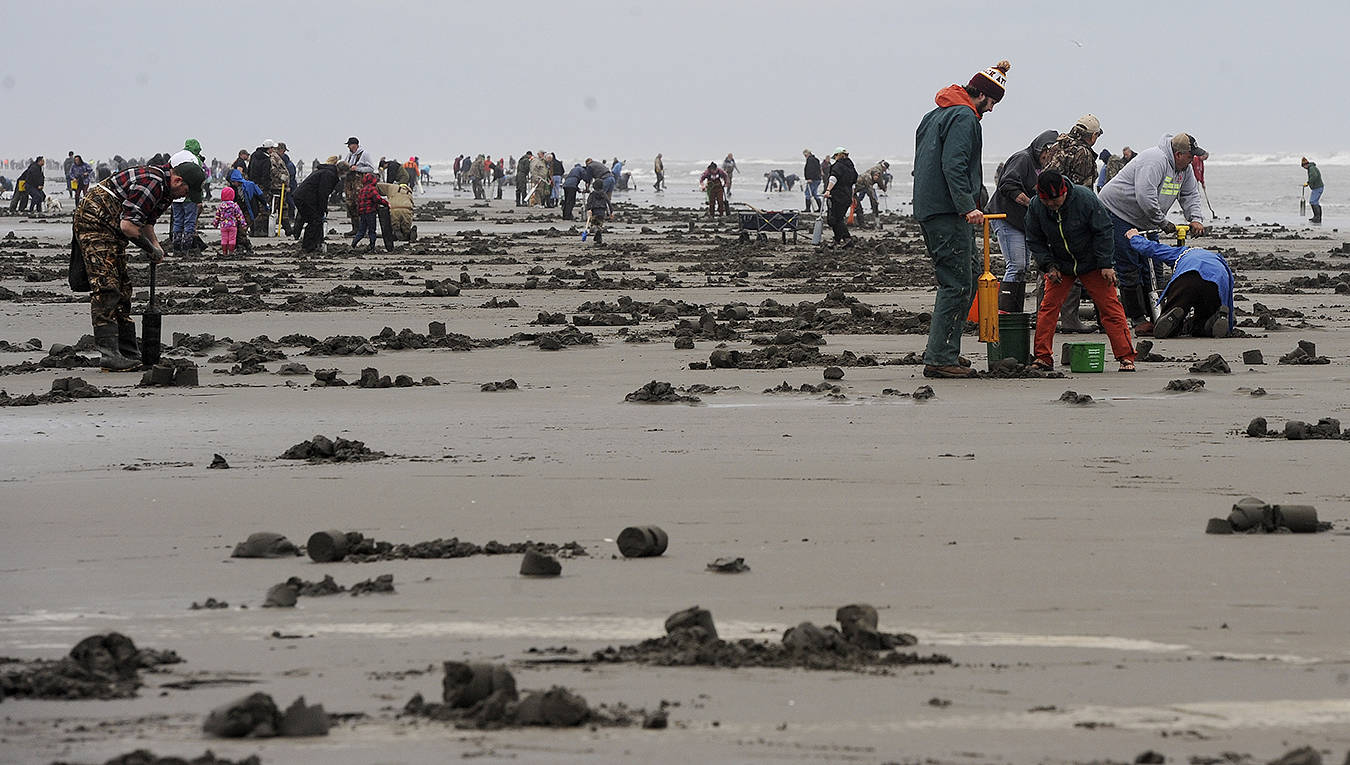OLYMPIA—Washington’s ocean beaches will remain closed to razor clam harvest through at least Nov. 12 after test results on razor clams dug at Long Beach indicate levels of domoic acid that exceed the threshold (20 parts per million) set by state public health officials for safe consumption.
WDFW managers have cancelled digs previously anticipated for Oct. 31- Nov. 3 and await additional test results prior to announcing whether digs tentatively scheduled for Nov. 13-19 and beyond can move forward.
WDFW has already seen significantly higher than normal participation on recent digs. To avoid concentrating clam diggers and disproportionately increasing the risk of COVID-19, razor clam beaches are closed statewide—though only Long Beach clams exceeded safe concentrations of domoic acid levels so far.
“We know how important these opportunities are to Washington citizens and coastal communities, and we’re looking to reopen as soon as it’s safe to do so,” said Larry Phillips, WDFW’s coastal region director. “Yet, we also know that these toxins have a tendency to hang on – it’s not inconceivable that we’ll have to wait until December before we’re clamming again. When that time comes, we’re still going to need people to practice good social distancing behaviors as they visit coastal communities.”
“Fortunately, we planned well, consulted communities and opened earlier in September,” said Philips. “What that means is razor clam diggers have already made more than 80,000 trips and harvested nearly 1.2 million clams this year.”
Domoic acid, a natural toxin produced by certain types of marine algae, can be harmful or even fatal if consumed in sufficient quantities. More information about domoic acid, as well as current levels at ocean beaches, can be found on WDFW’s domoic acid webpage.
Tentative Digs
Razor clam managers with the agency previously announced tentative digs through December, providing opportunities to dig while maintaining social distancing.
Final approval of tentatively scheduled openings depends on results of marine toxin tests conducted by Washington’s Department of Health (DOH).
Public health officials will also be closely monitoring COVID-19 infection rates throughout the digging season, and WDFW may make in-season adjustments to the schedule if necessary to reduce public health risks.
The tentative razor clam digs through December, along with low tides and beaches, are listed below:
P.M. TIDES:
Nov. 13, Friday, 4:58 pm, -0.3; Long Beach, Twin Harbors, Mocrocks
Nov. 14, Saturday, 5:45 pm, -1.3; Long Beach, Twin Harbors, Copalis
Nov. 15, Sunday, 6:32 pm, -1.7; Long Beach, Twin Harbors, Mocrocks
Nov. 16, Monday, 7:19 pm, -1.8; Long Beach, Twin Harbors, Copalis
Nov. 17, Tuesday, 8:06 pm, -1.6; Long Beach, Twin Harbors, Mocrocks
Nov. 18, Wednesday, 8:56 pm, -1.1; Long Beach, Twin Harbors, Copalis
Nov. 19, Thursday, 9:47 pm, -0.5; Long Beach, Twin Harbors, Mocrocks
Dec. 1, Tuesday, 7:14 pm, -0.4; Long Beach, Twin Harbors, Copalis
Dec. 2, Wednesday, 7:51 pm, -0.4; Long Beach, Twin Harbors, Mocrocks
Dec. 3, Thursday, 8:30 pm, -0.3; Long Beach, Twin Harbors, Copalis
Dec. 4, Friday, 9:12 pm, -0.1; Long Beach, Twin Harbors, Mocrocks
Dec. 12, Saturday, 4:44 pm, -0.8; Long Beach, Twin Harbors, Mocrocks
Dec. 13, Sunday, 5:32 pm, -1.4; Long Beach, Twin Harbors, Copalis
Dec. 14, Monday, 6:19 pm, -1.7; Long Beach, Twin Harbors, Mocrocks
Dec. 15, Tuesday, 7:05pm, -1.7; Long Beach, Twin Harbors, Copalis
Dec. 16, Wednesday, 7:50 pm, -1.5; Long Beach, Twin Harbors, Mocrocks
Dec. 17, Thursday, 8:35 pm, -1.0; Long Beach, Twin Harbors, Copalis
Dec. 18, Friday, 9:21 pm, -0.4; Long Beach, Twin Harbors, Mocrocks
Dec. 28, Monday, 5:43 pm, -0.2; Long Beach, Twin Harbors, Copalis
Dec. 29, Tuesday, 6:20 pm, -0.5; Long Beach, Twin Harbors, Mocrocks
Dec. 30, Wednesday, 6:57 pm, -0.7; Long Beach, Twin Harbors, Copalis
Dec. 31, Thursday, 7:34 pm, -0.7; Long Beach, Twin Harbors, Mocrocks
No digging is allowed before noon during digs when low tide occurs in the afternoon or evening.



